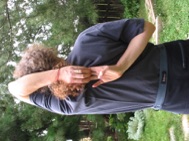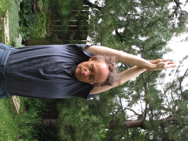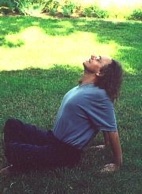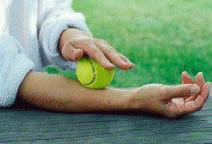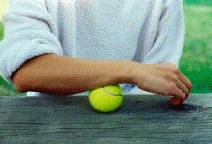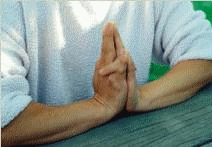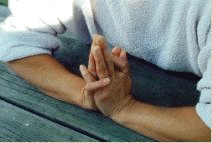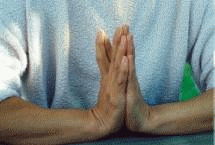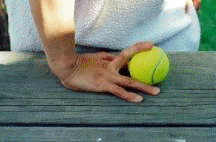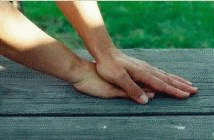
David Sawyer's note: I developed chronic tendonitis in my wrists and forearms 20 years ago, as a result of over-practice and bad practice with my shakuhachi. Eventually my hands became so weak that I couldn't use them to pick up anything heavier than a fork. I couldn't open doors, reach into the refrigerator, write etc. I sought help in various places but it was difficult to find professional expertise.
The holding of tension in the body whilst playing is subtle and harmful. I had quite a time learning to recognize when tension arose, where, and what to do about it as I played. This understanding was critical to reforming my playing style into a healthier way.
The musical world is still surprisingly ignorant about appropriate therapies for physical issues arising from playing. The culture has become more educated, but by and large, there is still a big comprehension gap. I know many injured musicians, some even terminally injured, who are either not getting treatment, have poor practice skills, or are receiving inappropriate care or advice from various sources.
My physical therapist is bemused by all of it….he can’t understand why there isn’t basic knowledge in music schools, colleges and on stage, about soft tissue, bone and nerve/tendon care. It’s what he does every day, as a sports therapist. No mystery.…it’s not even an esoteric area of medicine.
I have a young professional flautist just out of college, who is studying shakuhachi. At age 23, she came to me already severely injured, just from the rigors of college performance and practice. She told me there is zero, absolutely no oversight as to how students are faring with their bodies, or how heavily they are scheduled each day in practice or performance in her music school. Some days she would have her hands on her flute for 12 hours, just fulfilling the requirements of course and ensemble practice. Yes, there are courses scheduled in Alexander Technique and injury prevention, but the students are not monitored for body overuse or hearing damage. In the sports world, or the dance world, there is far more awareness, preventative training and therapy built into performers/athletes daily practice.
Respect
I learnt that playing injuries are best treated with great respect, and accorded constant care. If you have become disabled from playing a few times, with recovery in between, you may have a tendency towards injury which could be something you'll have to live with as long as you want to be a musician. You need to become very careful how you use your body in everyday activities and learn when 'enough is enough' BEFORE injury shows up. Examples: reaching into a refrigerator for a carton of milk. AVOID! Any extension of your arm, to which a weight is attached (milk) is potentially injurious if you are already in recovery.
Instead of reaching into the fridge, cosy up to the shelf with your body and use both hands in a short reach, to grasp the milk. When getting up from a chair, lean forward with your body and get movement upwards from your knees without using hands at all. When opening doors, use your shoulder, not your hands to push open. Don't do any lifting which results in a biceps 'curl', this can increase trauma to your tendons. Don't spend hours on a keyboard. If you do, then be mindful of stretching, posture, and taking decent breaks. This consciousness extends to ALL of your everyday movements and is critical to your recovery.
Recovery
Injured tendons need to be given a low impact recovery period (sometimes as long as several months...it's a slow process). This means: be gentle with your hands all day every day until you are out of the acute stage and can manage gentle strengthening exercises. Strengthening also promotes healing and mobility.
Stretching is part one of your hand care program. This, together with hot/cold baths actively promotes healing.
Part two, and equally important, is to strengthen your shoulders, arms, wrists and hands, after you are out of the acute injury stage. You can perform strengthening exercises which address the trauma without deepening the injuries. Avoid applying machismo to your strengthening exercises, you'll only deepen the injury. It's the domain of the sports therapist to offer good advice about which exercises can help your specific weaknesses. One set is illustrated below. Start with light weights and lift every other day, gently. Free weights are better because you have greater control over micro-movements and the danger of over-use.
The series of exercises illustrated below is a gentle day-to-day program that can significantly ease and help heal the trauma arising in the hands of injured musicians. The exercises are designed to be used at any time of day, and can become part of your daily musical practice.
My disclaimer: I am a musician and a cronic sufferer of tendonitis. I am not a doctor and I offer this program because I have found relief and healing (as have many others) and I have dramatically increased my ability to engage with my instrument. Obviously there are medical conditions these exercises cannot address. Use them at your own discretion and see a doctor if pain persists. The exercises are in order.
The long term
This is a life-long process, and a great outcome to work towards is to be able to increase the length of your episodes of healthy playing to where you can be satisfied by the length of time you are able to play without injury.
Become very aware of the tiny warning signs that tell you that you are moving into unhealthy practice and into injury. Rest often. Trauma shows up MANY HOURS AFTER the injury has taken place and if you keep playing, you don't give yourself a chance to notice that trauma is approaching. You will feel it as a warmth in the wrists, pain in the hands/forearms/elbows, or a general feeling of weakness in the arms and shoulders.
Instrument choice
If you are a shakuhachi player, your choice of instrument will have a major effect on your injury. My experiences have led me to the following understandings:
Lighter flutes make a big difference to the stress on your body. When injured, I play a 1.8 shakuhachi that weighs only 250g, and I hold it like a feather. I play nothing longer than a 1.9 (at 300g). Adding 100g to the weight makes a big difference. Likewise, flutes that are balanced strongly towards the root end can be particularly injurious. If the root is chunky and there is a lot of ji in the lower half, the 'bending moment' on your hands is great, and so is the effort to hold it in position.
Good practice for injured musicians
--Play a lightweight instrument.
--Avoid playing difficult pieces with fast passages.
--Stretch before and after playing, and at other times too.
--Don't grip your instrument. Hold it with minimal touch and play it that way.
--Take regular breaks while practicing.
--Care for your injury is 24/7 and extends to all your daily activities, outside of music practice.
Yoga!!!
In my own case, I have found regular yoga practice to be the single most effective way to build strength, relieve localized muscle tension, and increase healthy music playing time. It's important to be kind to yourself and modify-modify-modify throughout your yoga asana practice. At the first sign of over-strain, go into a less demanding version of the asana. It took me a couple of months to be able to do more than three 'downward dogs' in one session. Slow development of strength and healing is the best development. You will discover 'holding' and weaknesses in your body framework you never realized you had
1. Shoulder Stretch (30 seconds)
Plant your feet firmly on the ground, slightly apart. Reach above your head with palms together, breathing deeply. Feel the stretch throughout your body, pull upwards as much as you can. Breathe slowly and evenly. Rest and repeat, swapping hands.
2. Shoulder Stretch (20 seconds)
Reach behind with both hands as shown. Go into this stretch slowly. Make sure the upper forearm is feeling the stretch..don't bend backwards. Swap hands and repeat. If you can't do this one, go as far as you can into the stretch, or use a strap between the hands. After days or weeks, you will increase your reach.
3. Shoulder Stretch (30 seconds)
Sit cross-legged and place your palms on the ground just behind you, fingers together pointing forwards, hands a shoulder-width apart. Gently arch your back, arms straight, allowing your chest to push out and up while your shoulders, arms and wrists feel the stretch. This is super-nice for blood flow all through the shoulder girdle, arms, wrists and hands!
4. Self massage (one minute)
Allow your arm to relax, palm upwards on a firm surface. Using a tennis ball and your other hand, gently massage the tendons through the forearm and wrist in a circular motion along the length of the arm. Keep everything relaxed, especially both your hands and shoulders. If necessary, turn the forearm over and massage the top of the arm too. Anywhere you have pain, the ball can gently massage. The exercise is repeated with the ball on the table and the arm/wrist moving gently, without applied pressure, over the ball.
5. Folding Fingers (8 seconds each)
Lay your forearms on the table in front of you, palms together pointing upwards. Take a pair of fingers and cross them. Hold for a few seconds, cross them the other way and hold for a few seconds. Repeat with each pair of fingers. All other fingers not being crossed should remain straight, pointing upwards and together. If this is too hard with forearms flat on the surface, you can bring your hands off the table slightly, elbows remaining, to relieve the posture. Shoulders are relaxed. Over time your mobility should improve to where you can leave your forearms on the table.
6. Folding pairs of Fingers (8 seconds each)
Repeat the above exercise but this time take any two pairs of fingers and cross them first one way then the other. Pairs can be adjacent or separated. Try all possible permutations, gently, shoulders relaxed. All other fingers remain straight and together.
7. Finger slides (8 seconds each)
With palms together and forearms on the table, Take each pair of fingers and cant the pair, first one way, then the other, keeping the fingers together so that one finger slides against its opposite. Do this with each finger pair. This directly addresses the individual tendons in each wrist.
8. Finger stretch (8 seconds each)
Take your tennis ball again and whilst standing, place your hand flat on the table with your arm roughly vertical. (This angle can be relaxed if the exercise is too difficult). Place the ball under each finger in turn and feel the stretch for a few seconds. A smaller ball can be used if necessary.
9. Wrist flexion
Stand and place one hand flat on the table pointing away from your body. Take your other hand and place it on top, applying a little downwards holding pressure. Try to pull the bottom hand from under the top hand whilst simultaneously rotating the wrist of the bottom hand, first one way then the other (like turning a doorknob).
Sports Therapy
I use the services of a sports therapist who educated me as to the interrelationships of muscles, tendons, nerves and blood supply in the shoulder girdle, arms and hands, fingers. Manipulation, release, strengthening and massage all contribute to staying a healthy musician. It has changed my playing life.
Hot and cold baths
To rapidly address pain, tension and inflammation, hot and cold baths are a marvel. Find two waste bin size receptacles, deep enough to hold both your hands and forearms. Fill one with very hot water (you be the judge of 'hot') and the other with cold water and ice cubes. Plunge your arms into the cold bath for as long as you can (several minutes) and then go to the hot bath until you feel the warming, tingling effect. Repeat this for 3 cycles, ending with the hot bath. Do this up to 3 times a day including just before bedtime...it can be very healing. For chronic sufferers this can be carried out daily until you cease to feel the direct benefits. Coupled with the hand exercises it's powerful.
The Armaid
This self-massage tool is a remarkably effective way to partially duplicate a hands-on deep tissue massage on the arm fascia, releasing tensions and adhesions built up from overuse. Excellent for musicians, in my opinion.
Rolfing
As we get older we live with deeply embedded tensions that twist and distort our balance, depsite our own best intentions. Rolfing is a ten session program of releasing, systematically, those built up tensions so that our body can realign itself better under gravity. I found it very moving and helpful overall, with very long lasting effects.
